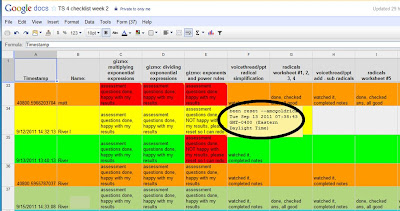Frankly I LOVE evrything about it! I really like the fact that the VTs can be watched from home even if my internet is slow and hates me :) BTW cool checklist
Wow! I just love Flipped classes.It’s great to be able to have group-work, or even class-work, without having to be afraid to ask questions about any of the work. And it’s great homework-wise because it gives us more time for other class’ homework and assignments.Flipped classes FTW!
I like it, I like how i can look at the checklist and do a bunch of notes whenever i want and not have to wait to do them in class everyday. It makes things less stressful, because i don't feel like I have a bunch of homework when I know what is planned for the week and get it done as soon as possible. I'm happy with the flipped class, i can't think of anyway to improve it.
Coming to school and doing the work here, getting the help I need, and actually discussing the work with the other people in my class is awesome!:) :) I also like the fact that on nights that I don't work, I can go ahead and do the homework for night/days to come! :) Lovin' It!
Honestly, I've been sitting here for a minute trying to think about what I don't like and I can't think of anything.And here are some that are mixed (my bold):
I like that we are able to ask you questions during class about work we are having problems with during class time, although i dont like that when we are sent home with homework we only have a voice thread to learn from and cant ask questions about the lesson. Nothing to be imporved.
I think it is a lot easier not having homework in the evening, but it is a bit harder to take notes and do examples from voicethreads than it is during class.
I like it but in class we dont have that much time to work cause we always have to go over something first so it only leaves us with like 30 minutes to do work. sometimes not even that.
I like the voicethreads better than the khan videos! The voicethreads are not that bad its only when we have voicethreads every night plus the worksheets you give us plus all our other homework it really gets too much but one or 2 per week is fine. I also think the flip classroom works part time because seriously you have time to answer like 2 or 3 people a class and a lot more so i think this part dosnt work at all but doing the work during class i dont mind. I wouldnt mind either if it was the other way because i think it wouldnt really be different than what is happeneing now.So important for me to hear all of this. It makes me realize a few mistakes I've been making:
- I have been talking too much. Partly that is because I can't see them, and I feel insecure about what they are doing or not doing. Why? I don't know. But they could have used more class time to work.
- I also have been piling on the lessons in too short a time in one particular class. That class has a lot of kids who are very weak and need almost constant help, so I need to slow things down a bit. Letting that government June exam get the best of me I guess...
- I have tried to answer all questions posted on the voicethreads asap but then I forget to tell them that. They could always check back themselves, but it would be nice if they could get a notification when I do that. SO remind them to ask questions but when they do check back.
- That they actually ARE doing group work even when I haven't specifically asked them to. It IS happening organically, at least in some classes, just as I had hoped!
- How well flipping works, and the way it works in general, can be so different from one class to another. My Science Math kids seem to be almost 100% in love with it, but my Tech Sci kids, not all are lovin' it. All the mixed comments came from that group. Makes sense, because they need more time to get their work done, and they need more help, and they are not getting either. I can't honestly say I didn't know it, but I definitely didn't know THEY knew it!
What I shall now do:
- I shall renew my efforts to shut up.
- I shall be more systematic helping individual students. 5 mins per, and if that's not enough, they work with someone else, or rewatch the lesson, or go to khanacademy for a video or a practice.
- I shall ALWAYS include, in each week's checklist, a open-ended question, that gives them a chance to speak their mind. Maybe this will be a natural progression for them into blogging.
- I shall tell them that was my evil plan all along. Then they'll have Minds = blown.
















